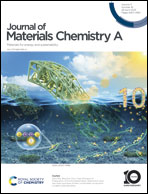Pulsed-waveform electrocatalytic detoxification of hexavalent chromium promoted by pseudocapacitive effects†
Abstract
Pulsed electrocatalysis has emerged as an attractive way to improve the reaction efficiency and selectivity by employing an alternating power on/off strategy to regulate ion transport and reduce concentration polarization. However, the synergistic effects of the pulsed voltage and electrode properties, which are essential and practical, have received negligible attention. Here, we propose a pulsed-voltage strategy that utilizes the pseudocapacitive effects of polyaniline (PANI) to improve the efficiency of hexavalent chromium (Cr(VI)) detoxification. In situ Raman spectroscopy analysis confirmed that the electrical energy stored as pseudocapacitance during the on-voltage time could be released to spontaneously reduce Cr(VI) during the off-voltage time. The pulsed voltage with low frequencies of 0.01–1 Hz efficiently enhanced the reaction kinetics of Cr(VI) reduction, owing to the improvement of mass transfer efficiency, electrode reaction selectivity, and overall faradaic efficiency. The pulsed voltage of 1.5 V (0.1 Hz, on–off ratio = 50%) increased the Cr(VI) reduction efficiency and kinetic coefficient by 65% and 147%, respectively, compared with the constant voltage in a beaker reactor. The pulsed-voltage strategy applied in a flow-through electrochemical reactor achieved an 89.2% improvement in Cr(VI) reduction compared to that obtained at a constant voltage. Moreover, a steady conversion efficiency of >90% was achieved for more than 22 h. These results demonstrate that the coupling mechanisms of the pulsed voltage and pseudocapacitive electrode provide new opportunities for achieving fast-kinetic electrocatalytic reactions.



 Please wait while we load your content...
Please wait while we load your content...